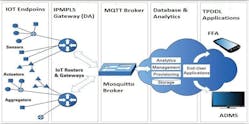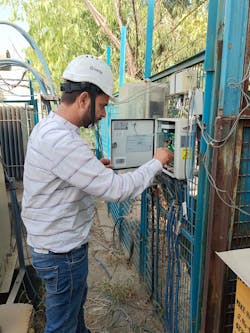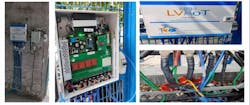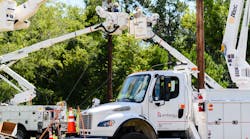Tata Power Delhi Distribution Ltd. is a joint venture between Tata Power, with 51% ownership, and the Government of National Capital Territory of Delhi, with 49%. Since its inception in 2002, the organization has implemented groundbreaking technologies such as an advanced distribution management system, an integrated geographic information system, advanced metering infrastructure, automated demand response, a smart streetlight management system, field force automation, distribution network upgrades and a smart billing system. As a result of these improvements over the last 21 years, the overall aggregate technical and commercial losses were reduced from 53% in 2002 to 6.39% in 2023, and the system availability index improved from 70% to 99.9%, respectively.
Low-voltage distribution can be a significant challenge for electric utilities. Generally, most technology has been implemented on high-voltage and extra-high-voltage networks. On the contrary, most customers are connected to low-voltage networks. At Tata Power Delhi Distribution Ltd. (DDL), the sub-transmission network is completely automated and 25% of substations in the 11-kV primary distribution network are fully automated. However, the low-voltage network lacked automation.
With the proliferation of rooftop solar, the power flow in the low-voltage network is now bidirectional, a significant challenge for operational safety. Utilities must be equipped with robust technologies to measure and monitor power flow and power quality on the low-voltage network. At the same time, they should prepare a specific action plan to improve power quality, reduce technical losses and enhance network safety. As part of its action plan, Tata Power DDL implemented state-of-the-art IoT-based automation to operate and efficiently manage the low-voltage distribution network in the northern and northwestern parts of Delhi.
IoT Automation
With 24,772 distribution feeders, Tata Power DDL’s low-voltage network is around 6750 circuit km long — and continues to grow annually. Because its network lacked automation, the utility did not receive any firsthand information before, during or after power outages. It only knew an outage occurred when a customer called in to report one. The total number of complaints on the low-voltage side — stemming from low-voltage circuit-breaker tripping — increased by 57% in fiscal year 2017-2018 compared with the year prior, and the average supply restoration time was as high as 66.86 minutes.
To implement IoT automation through an end-to-end architecture, Tata Power DDL first identified the critical substations based on certain conditions. Some criteria were weighted more heavily, such as feeders with a high number of customers connected, frequent tripping feeders, substations in heavy traffic patches, feeders with high fault restoration times, feeders affected by high transient faults and those with a high volume of complaints.
Each IoT edge device was designed to monitor the digital status of all isolators, breakers, fault passage indicator and gas pressure sensors of one four way ring main unit. The devices also communicate with a minimum of four Modbus relays. In addition, they monitor the temperature of the transformer bushing and send an alert when a hot spot is created in any phase. The devices also measure the daily peak load and current harmonics of all outgoing low-voltage feeders as well as the active, reactive and apparent power of distribution transformers.
End-To-End Integration
Eight separate digital inputs on each of the devices monitor medium-voltage breaker status, ring main unit SF6 leakage issues and the status of the fault passage indicator. IoT device integration is governed by the state of the information technology-operational technology (IT-OT) integration at Tata Power DDL. The IoT devices communicate using the secure MQTT messaging protocol with the broker, and the broker is further connected with the database and application servers. The communication infrastructure is on the 4G multiprotocol label switching network.
The IoT application server is integrated with the ADMS to share outage information with the central supervisory control and data acquisition system. The ADMS servers are integrated with the field force automation system and SAP IS-U customer care center. When an outage is reported at the site, the IoT device alerts the IoT application server through broker services over the secure wireless medium. The IoT application server then sends the information to the ADMS system.
Once an outage is created in ADMS, the information triggers the SAP IS-U application. The nearest field crew receives real-time updates about the breakdown. In addition, the call center uses the information to update customers about the outage and expected supply restoration time. After power is restored, the IoT device sends closing information to the IoT applications. The IoT applications send this information to the ADMS, FFA and SAP IS-U applications. As a result, outage jobs get closed through an automatic chain, and no manual intervention is required.
Inspiring Results
The end-to-end IoT infrastructure has been implemented in more than 300 substations containing 1589 low-voltage breakers, 481 ring main units, 400 distribution transformers, 481 fault passage indicators and 121 relays. Around 318,000 customers are supported by IoT devices. The outcome of this large-scale implementation has been multidimensional and inspiring. The project kicked off in December 2020 and was fully implemented by March 2022.
Prior to the implementation, the total number of customer complaints stemming from low-voltage circuit-breaker tripping had been on the rise, increasing from 31% in fiscal year 2019 to 46% in fiscal year 2020. After implementation, complaints decreased gradually by 4.77%, 39.44% and 35.85% in fiscal years 2020-2021, 2021-2022 and 2022-2023, respectively. Integration of the real-time tripping information helps field crews to restore faults more quickly. The low-voltage IoT sends parallel information to the crew by directly triggering an SMS text when an outage has occurred as well as through the ADMS integration. As a result, the minimum-time-to-restore low-voltage breakdown was reduced from 19.72% in fiscal year 2021-2022 and 28.09 % in 2022-2023.
Maintenance and network enhancement plans are now designed based on tripping events, load profiles and the energy profiles of individual feeders captured on the IoT dashboard. The regional team takes corrective actions on the network based on the tripping statistics captured.
To reduce technical losses, unbalanced feeders are balanced by shifting the load to less loaded phases. To date, corrective action has been taken on 582 low-voltage feeders. Capital expenditure planning also is optimized to identify underloaded low-voltage feeders, and additional load shifting also is performed on light-loaded feeders from overloaded feeders.
The multidimensional benefits of the low-voltage IoT application have inspired Tata Power DDL to scale up the project and extend its benefits to another 640,000 customers in northern and northwestern Delhi. Real-time power factor measurement of distribution transformers, energy auditing data and current harmonic measurement of low-voltage feeders also have made it possible for the utility to analyze customer load profile, energy pilferage, power-quality issues and reactive power issues in the low-voltage network.
IoT-based low-voltage automation technology is robust, compatible with any kind of air circuit breaker and easily deployable. Other utilities in urban areas could benefit from this technology to effectively digitalize their low-voltage grids.
Shrinjoy Bagchi ([email protected]) is an accomplished professional with over 17 years of experience in power distribution utilities. He holds a bachelor of technology degree in eectrical engineering and M. tech in energy & environmental management from IIT Delhi. He has national and international publications in the field of power system protection, automation, IoT. Currently Bagchi works as the head of department (Protection & Automation) at Tata Power Delhi Distribution limited where he oversees the implementation of Digital Grid, Advanced Distribution Management System, Distribution Automation, Smart meter DI/DO integration, large scale IoT deployment in utility landscape, OT Cybersecurity.
H.C. Sharma has a B.Tech degree in electrical engineering from the Aligarh Muslim University, where he was awarded the Gold Medalist honor, and earned a post-graduate certification in business management from XLRI, Jamshedpur. He is the chief of business development, contracts, stores and technical services at Tata Power Delhi Distribution Ltd. Sharma heads the function that includes business development, stores, power system control, quality assurance and technical services. He has worked on many projects and been instrumental in the development of plant engineering and quality assurance systems for the utility. He also has also worked on various verticals of projects that include design, engineering, quality assurance, and procurement and execution.






